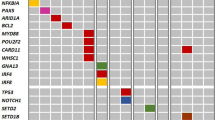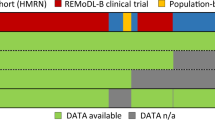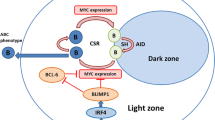Abstract
Nodular lymphocyte predominant Hodgkin lymphoma (NLPHL)—a subtype of Hodgkin lymphoma (HL)—is characterized by a low content of tumor cells, the lymphocyte predominant (LP) cells. Transformation into diffuse large B-cell lymphoma (DLBCL) occurs in about 10% of patients. We performed whole-genome mutation analysis of the DLBCL components from two composite lymphomas consisting of clonally related NLPHL and DLBCL as a means to identify candidate tumor suppressor genes and oncogenes in NLPHL. The analysis of LP cells for selected mutations of the DLBCL revealed that most mutations are also present in the LP cells, indicating a close relationship between the two components. The analysis of 62 selected genes in NLPHL by targeted ultra-deep sequencing revealed three novel highly recurrently mutated genes (each mutated in ~50% of cases), that is, DUSP2, SGK1 and JUNB. SGK1 was expressed in the LP cells of primary NLPHL cases and in the NLPHL cell line DEV. Administration of an SGK1 inhibitor induced apoptosis in the NLPHL cell line DEV and the DLBCL cell line Farage, suggesting a pathogenetic role of SGK1 in the LP and DLBCL cells. In summary, the present study identifies SGK1, DUSP2 and JUNB as novel key players in the pathogenesis of NLPHL.
This is a preview of subscription content, access via your institution
Access options
Subscribe to this journal
Receive 12 print issues and online access
$259.00 per year
only $21.58 per issue
Buy this article
- Purchase on Springer Link
- Instant access to full article PDF
Prices may be subject to local taxes which are calculated during checkout



Similar content being viewed by others
References
Saarinen S, Pukkala E, Vahteristo P, Makinen MJ, Franssila K, Aaltonen LA . High familial risk in nodular lymphocyte-predominant Hodgkin lymphoma. J Clin Oncol 2013; 31: 938–943.
Anagnostopoulos I, Hansmann ML, Franssila K, Harris M, Harris NL, Jaffe ES et al. European Task Force on Lymphoma project on lymphocyte predominance Hodgkin disease: histologic and immunohistologic analysis of submitted cases reveals 2 types of Hodgkin disease with a nodular growth pattern and abundant lymphocytes. Blood 2000; 96: 1889–1899.
Brune V, Tiacci E, Pfeil I, Döring C, Eckerle S, van Noesel CJ et al. Origin and pathogenesis of nodular lymphocyte-predominant Hodgkin lymphoma as revealed by global gene expression analysis. J Exp Med 2008; 205: 2251–2268.
Diehl V, Sextro M, Franklin J, Hansmann ML, Harris N, Jaffe E et al. Clinical presentation, course, and prognostic factors in lymphocyte-predominant Hodgkin's disease and lymphocyte-rich classical Hodgkin's disease: report from the European Task Force on Lymphoma Project on Lymphocyte-Predominant Hodgkin's Disease. J Clin Oncol 1999; 17: 776–783.
Hansmann ML, Stein H, Fellbaum C, Hui PK, Parwaresch MR, Lennert K . Nodular paragranuloma can transform into high-grade malignant lymphoma of B type. Hum Pathol 1989; 20: 1169–1175.
Küppers R, Engert A, Hansmann ML . Hodgkin lymphoma. J Clin Invest 2012; 122: 3439–3447.
Fan Z, Natkunam Y, Bair E, Tibshirani R, Warnke RA . Characterization of variant patterns of nodular lymphocyte predominant Hodgkin lymphoma with immunohistologic and clinical correlation. Am J Surg Pathol 2003; 27: 1346–1356.
Hartmann S, Eichenauer DA, Plutschow A, Mottok A, Bob R, Koch K et al. The prognostic impact of variant histology in nodular lymphocyte-predominant Hodgkin lymphoma: a report from the German Hodgkin Study Group (GHSG). Blood 2013; 122: 4246–4252.
Boudova L, Torlakovic E, Delabie J, Reimer P, Pfistner B, Wiedenmann S et al. Nodular lymphocyte-predominant Hodgkin lymphoma with nodules resembling T-cell/histiocyte-rich B-cell lymphoma: differential diagnosis between nodular lymphocyte-predominant Hodgkin lymphoma and T-cell/histiocyte-rich B-cell lymphoma. Blood 2003; 102: 3753–3758.
Eichenauer DA, Engert A . Antibodies and antibody-drug conjugates in the treatment of Hodgkin lymphoma. Eur J Haematol 2014; 93: 1–8.
Hartmann S, Martin-Subero JI, Gesk S, Hüsken J, Giefing M, Nagel I et al. Detection of genomic imbalances in microdissected Hodgkin and Reed-Sternberg cells of classical Hodgkin's lymphoma by array-based comparative genomic hybridization. Haematologica 2008; 93: 1318–1326.
Schmitz R, Hansmann ML, Bohle V, Martin-Subero JI, Hartmann S, Mechtersheimer G et al. TNFAIP3 (A20) is a tumor suppressor gene in Hodgkin lymphoma and primary mediastinal B cell lymphoma. J Exp Med 2009; 206: 981–989.
Mottok A, Renne C, Willenbrock K, Hansmann ML, Brauninger A . Somatic hypermutation of SOCS1 in lymphocyte-predominant Hodgkin lymphoma is accompanied by high JAK2 expression and activation of STAT6. Blood 2007; 110: 3387–3390.
Wlodarska I, Nooyen P, Maes B, Martin-Subero JI, Siebert R, Pauwels P et al. Frequent occurrence of BCL6 rearrangements in nodular lymphocyte predominance Hodgkin lymphoma but not in classical Hodgkin lymphoma. Blood 2003; 101: 706–710.
Biasoli I, Stamatoullas A, Meignin V, Delmer A, Reman O, Morschhauser F et al. Nodular, lymphocyte-predominant Hodgkin lymphoma: a long-term study and analysis of transformation to diffuse large B-cell lymphoma in a cohort of 164 patients from the Adult Lymphoma Study Group. Cancer 2010; 116: 631–639.
Al-Mansour M, Connors JM, Gascoyne RD, Skinnider B, Savage KJ . Transformation to aggressive lymphoma in nodular lymphocyte-predominant Hodgkin's lymphoma. J Clin Oncol 2010; 28: 793–799.
Hartmann S, Eray M, Doring C, Lehtinen T, Brunnberg U, Kujala P et al. Diffuse large B cell lymphoma derived from nodular lymphocyte predominant Hodgkin lymphoma presents with variable histopathology. BMC Cancer 2014; 14: 332.
Küppers R, Rajewsky K, Zhao M, Simons G, Laumann R, Fischer R et al. Hodgkin disease: Hodgkin and Reed-Sternberg cells picked from histological sections show clonal immunoglobulin gene rearrangements and appear to be derived from B cells at various stages of development. Proc Natl Acad Sci USA 1994; 91: 10962–10966.
Küppers R, Dührsen U, Hansmann ML . Pathogenesis, diagnosis, and treatment of composite lymphomas. Lancet Oncol 2014; 15: e435–e446.
Ame JC, Spenlehauer C, de Murcia G . The PARP superfamily. Bioessays 2004; 26: 882–893.
Lang R, Hammer M, Mages J . DUSP meet immunology: dual specificity MAPK phosphatases in control of the inflammatory response. J Immunol 2006; 177: 7497–7504.
Ranjan R, Deng J, Chung S, Lee YG, Park GY, Xiao L et al. The transcription factor nuclear factor of activated T cells c3 modulates the function of macrophages in sepsis. J Innate Immun 2014; 6: 754–764.
Goncalves A, Burckstummer T, Dixit E, Scheicher R, Górna MW, Karayel E et al. Functional dissection of the TBK1 molecular network. PLoS One 2011; 6: e23971.
George A, Morse HC 3rd, Justice MJ . The homeobox gene Hex induces T-cell-derived lymphomas when overexpressed in hematopoietic precursor cells. Oncogene 2003; 22: 6764–6773.
Ott RG, Simma O, Kollmann K, Weisz E, Zebedin EM, Schorpp-Kistner M et al. JunB is a gatekeeper for B-lymphoid leukemia. Oncogene 2007; 26: 4863–4871.
Steidl C, Shah SP, Woolcock BW, Rui L, Kawahara M, Farinha P et al. MHC class II transactivator CIITA is a recurrent gene fusion partner in lymphoid cancers. Nature 2011; 471: 377–381.
Schneider M, Schneider S, Zuhlke-Jenisch R, Klapper W, Sundström C, Hartmann S et al. Alterations of the CD58 gene in classical Hodgkin lymphoma. Genes Chromosomes Cancer 2015; 54: 638–645.
Reichel J, Chadburn A, Rubinstein PG, Giulino-Roth L, Tam W, Liu Y et al. Flow sorting and exome sequencing reveal the oncogenome of primary Hodgkin and Reed-Sternberg cells. Blood 2015; 125: 1061–1072.
Liso A, Capello D, Marafioti T, Tiacci E, Cerri M, Distler V et al. Aberrant somatic hypermutation in tumor cells of nodular-lymphocyte-predominant and classic Hodgkin lymphoma. Blood 2006; 108: 1013–1020.
Mathas S, Hinz M, Anagnostopoulos I, Krappmann D, Lietz A, Jundt F et al. Aberrantly expressed c-Jun and JunB are a hallmark of Hodgkin lymphoma cells, stimulate proliferation and synergize with NF-kappa B. EMBO J 2002; 21: 4104–4113.
Lang F, Bohmer C, Palmada M, Seebohm G, Strutz-Seebohm N, Vallon V . (Patho)physiological significance of the serum- and glucocorticoid-inducible kinase isoforms. Physiol Rev 2006; 86: 1151–1178.
Zhang J, Grubor V, Love CL, Banerjee A, Richards KL, Mieczkowski PA et al. Genetic heterogeneity of diffuse large B-cell lymphoma. Proc Natl Acad Sci USA 2013; 110: 1398–1403.
Pasqualucci L, Khiabanian H, Fangazio M, Vasishtha M, Messina M, Holmes AB et al. Genetics of follicular lymphoma transformation. Cell Rep 2014; 6: 130–140.
Fabbri G, Khiabanian H, Holmes AB, Wang J, Messina M, Mullighan CG et al. Genetic lesions associated with chronic lymphocytic leukemia transformation to Richter syndrome. J Exp Med 2013; 210: 2273–2288.
Braeuninger A, Küppers R, Strickler JG, Wacker HH, Rajewsky K, Hansmann ML . Hodgkin and Reed-Sternberg cells in lymphocyte predominant Hodgkin disease represent clonal populations of germinal center-derived tumor B cells. Proc Natl Acad Sci USA 1997; 94: 9337–9342.
Oeschger S, Bräuninger A, Küppers R, Hansmann ML . Tumor cell dissemination in follicular lymphoma. Blood 2002; 99: 2192–2198.
Lohr JG, Stojanov P, Lawrence MS, Auclair D, Chapuy B, Sougnez C et al. Discovery and prioritization of somatic mutations in diffuse large B-cell lymphoma (DLBCL) by whole-exome sequencing. Proc Natl Acad Sci USA 2012; 109: 3879–3884.
Morin RD, Mendez-Lago M, Mungall AJ, Goya R, Mungall KL, Corbett RD et al. Frequent mutation of histone-modifying genes in non-Hodgkin lymphoma. Nature 2011; 476: 298–303.
Pasqualucci L, Dominguez-Sola D, Chiarenza A, Fabbri G, Grunn A, Trifonov V et al. Inactivating mutations of acetyltransferase genes in B-cell lymphoma. Nature 2011; 471: 189–195.
Rausch T, Jones DT, Zapatka M, Stütz AM, Zichner T, Weischenfeldt J et al. Genome sequencing of pediatric medulloblastoma links catastrophic DNA rearrangements with TP53 mutations. Cell 2012; 148: 59–71.
Qian J, Wang Q, Dose M, Stütz AM, Zichner T, Weischenfeldt J et al. B cell super-enhancers and regulatory clusters recruit AID tumorigenic activity. Cell 2014; 159: 1524–1537.
Roberts SA, Lawrence MS, Klimczak LJ, Grimm SA, Fargo D, Stojanov P et al. An APOBEC cytidine deaminase mutagenesis pattern is widespread in human cancers. Nat Genet 2013; 45: 970–976.
Szremska AP, Kenner L, Weisz E, Ott RG, Passegué E, Artwohl M et al. JunB inhibits proliferation and transformation in B-lymphoid cells. Blood 2003; 102: 4159–4165.
Schif B, Lennerz JK, Kohler CW, Bentink S, Kreuz M, Melzner I et al. SOCS1 mutation subtypes predict divergent outcomes in diffuse large B-Cell lymphoma (DLBCL) patients. Oncotarget 2013; 4: 35–47.
Chu Y, Solski PA, Khosravi-Far R, Der CJ, Kelly K . The mitogen-activated protein kinase phosphatases PAC1, MKP-1, and MKP-2 have unique substrate specificities and reduced activity in vivo toward the ERK2 sevenmaker mutation. J Biol Chem 1996; 271: 6497–6501.
Leventaki V, Drakos E, Karanikou M, Psatha K, Lin P, Schlette E et al. c-JUN N-terminal kinase (JNK) is activated and contributes to tumor cell proliferation in classical Hodgkin lymphoma. Hum Pathol 2014; 45: 565–572.
Hall BA, Kim TY, Skor MN, Conzen SD . Serum and glucocorticoid-regulated kinase 1 (SGK1) activation in breast cancer: requirement for mTORC1 activity associates with ER-alpha expression. Breast Cancer Res Treat 2012; 135: 469–479.
Towhid ST, Liu GL, Ackermann TF, Beier N, Scholz W, Fuchß T et al. Inhibition of colonic tumor growth by the selective SGK inhibitor EMD638683. Cell Physiol Biochem 2013; 32: 838–848.
O'Neill D, Jones D, Wade M, Grey J, Nakjang S, Guo W et al. Development and exploitation of a novel mutant androgen receptor modelling strategy to identify new targets for advanced prostate cancer therapy. Oncotarget 2015; 6: 26029–26040.
Brickley DR, Agyeman AS, Kopp RF, Hall BA, Harbeck MC, Belova L et al. Serum- and glucocorticoid-induced protein kinase 1 (SGK1) is regulated by store-operated Ca2+ entry and mediates cytoprotection against necrotic cell death. J Biol Chem 2013; 288: 32708–32719.
Zhang L, Cui R, Cheng X, Du J . Antiapoptotic effect of serum and glucocorticoid-inducible protein kinase is mediated by novel mechanism activating I{kappa}B kinase. Cancer Res 2005; 65: 457–464.
Amato R, D'Antona L, Porciatti G, Agosti V, Menniti M, Rinaldo C et al. Sgk1 activates MDM2-dependent p53 degradation and affects cell proliferation, survival, and differentiation. J Mol Med (Berl) 2009; 87: 1221–1239.
Fagerli UM, Ullrich K, Stuhmer T, Holien T, Köchert K, Holt RU et al. Serum/glucocorticoid-regulated kinase 1 (SGK1) is a prominent target gene of the transcriptional response to cytokines in multiple myeloma and supports the growth of myeloma cells. Oncogene 2011; 30: 3198–3206.
Acknowledgements
We thank Sabine Albrecht, Smaro Soworka, Ottilja Buhr, Ekaterini Hadzoglou, Susanne Hansen, Elena Hartung, Julia Bein, Maria Kemele, Christina Jakobus, Ralf Lieberz, Christiane Wenk and the EMBL GeneCore sequencing team and the EMBL IT unit for excellent technical assistance. We thank Dr Frederike Schmid, Dr Friederike Schwartz and Dr Marc Seifert for helpful discussions. This project was supported by the Deutsche Forschungsgemeinschaft (grant HA6145/1-2). M-LH, CD and SN were supported by the Kassel Stiftung. RK and M-LH were supported by the German Cancer Consortium (DKTK), the BMBF (01KU1002F; International Cancer Genome consortium, ICGC) and the Wilhelm Sander Foundation (2014.136.1).
Author contributions
SH was involved in the study design, performed the research, analysis and interpretation of data and wrote the manuscript; BS, AL, MW, LF, CW, LT and BR performed the research, analysis and interpretation of data; CD and TR performed the biostatistical analysis and interpretation of NGS data; UB, MV and VB contributed the essential material and were involved in the interpretation of data; MP, RK and SN performed the analysis and interpretation of data, and were involved in drafting the manuscript; M-LH was involved in the study design, interpretation of data and drafting the manuscript.
Author information
Authors and Affiliations
Corresponding author
Ethics declarations
Competing interests
The authors declare no conflict of interest.
Additional information
Supplementary Information accompanies this paper on the Leukemia website
Supplementary information
Rights and permissions
About this article
Cite this article
Hartmann, S., Schuhmacher, B., Rausch, T. et al. Highly recurrent mutations of SGK1, DUSP2 and JUNB in nodular lymphocyte predominant Hodgkin lymphoma. Leukemia 30, 844–853 (2016). https://doi.org/10.1038/leu.2015.328
Received:
Revised:
Accepted:
Published:
Issue Date:
DOI: https://doi.org/10.1038/leu.2015.328
This article is cited by
-
Klassifikation der Hodgkin-Lymphome und verwandter Entitäten
Wiener klinisches Magazin (2024)
-
Evolution in the definition and diagnosis of the Hodgkin lymphomas and related entities
Virchows Archiv (2023)
-
The spectrum of nodular lymphocyte predominant Hodgkin lymphoma: a report of the lymphoma workshop of the 20th meeting of the European Association for Haematopathology
Virchows Archiv (2023)
-
Klassifikation der Hodgkin-Lymphome und verwandter Entitäten
Die Pathologie (2023)
-
Circulating tumor DNA in Hodgkin lymphoma
Annals of Hematology (2022)



